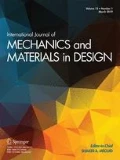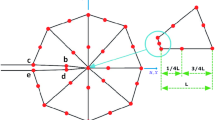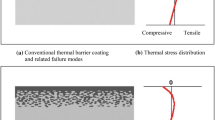Abstract
This work investigates the existing capabilities and limitations in numerical modeling of fracture problems in functionally graded materials (FGMs) by means of the well-known finite element code ABAQUS. Quasi-static crack initiation and growth in planar FGMs is evaluated. Computational results of fracture parameters are compared to experimental results and good agreement is obtained. The importance of the numerical fit of the elastic properties in the FE model is analyzed in depth by means of a sensitivity study and a novel method is presented. Several key computational issues derived from the continuous change of the material properties are also addressed and the source code of a user subroutine USDFLD is provided in the Appendix for an effective implementation of the property variation. The crack propagation path is calculated through the extended finite element method and subsequently compared to available experimental data. Suitability of local fracture criteria to simulate crack trajectories in FGMs is discussed and a new crack propagation criterion is suggested.










Similar content being viewed by others
References
Abanto-Bueno, J., Lambros, J.: An experimental study of mixed mode crack initiation and growth in functionally graded materials. Exp. Mech. 46(2), 179–196 (2006)
ABAQUS.: ABAQUS Version 6.13 Documentation. Dassault Systèmes Simulia Corp, Providence (2013)
Anderson, T.L.: Fracture Mechanics. Fundamentals and Applications, 3rd edn. Taylor and Francis CRC Press, Boca Raton (2005)
Anlas, G., Santare, M.H., Lambros, J.: Numerical calculation of stress intensity factors in functionally graded materials. Int. J. Frac. 104(2), 131–143 (2000)
Bao, G., Cai, H.: Delamination cracking in functionally graded coating/metal substrate systems. Acta. Mech. 45(3), 1055–1066 (1997)
Bao, G., Wang, L.: Multiple cracking in functionally graded ceramic/metal coatings. Int. J. Solids. Struct. 32(19), 2853–2871 (1995)
Becker Jr, T.L., Cannon, R.M., Ritchie, R.O.: Finite crack kinking and T-stresses in functionally graded materials. Int. J. Solids. Struct. 38(32–33), 5545–5563 (2001)
Butcher, R.J., Rousseau, C.E., Tippur, H.V.: A functionally graded particulate composite: preparation, measurements and failure analysis. Acta. Mater. 47(1), 259–268 (1999)
Carrillo-Heian, E.M., Carpenter, R.D., Paulino, G.C., Gibeling, J.G.: Dense layered molybdenum disilicide-silicon carbide functionally graded composites formed by field activated synthesis. J. Am. Ceram. Soc. 84(5), 962–968 (2001)
Chapa-Cabrera, J., Reimanis, I.E.: Crack deflection in compositionally graded Cu-W composites. Philos. Mag. A. 82(17–18), 3393–3403 (2002a)
Chapa-Cabrera, J., Reimanis, I.E.: Eects of residual stress and geometry on crack kink angles in graded composites. Eng. Fract. Mech. 69(14–16), 1667–1678 (2002b)
Chen, J., Wu, L., Du, S.: A modified J integral for functionally graded materials. Mech. Res. Commun. 27(3), 301–306 (2000)
Dolbow, J.E., Gosz, M.: On the computation of mixed-mode stress intensity factors in functionally graded materials. Int. J. Solids. Struct. 39(3), 2557–2574 (2002)
Eischen, J.W.: Fracture of nonhomogeneous materials. Int. J. Frac. 34, 3–22 (1987)
Erdogan, F.: Fracture mechanics of functionally graded materials. Compos. Eng. 5(7), 753–770 (1995)
Gasik, M.M.: Micromechanical modelling of functionally graded materials. Compos. Mater. Sci. 13, 42–55 (1998)
Gu, P., Asaro, R.J.: Crack deflection in functionally graded materials. Int. J. Solids. Struct. 34(24), 3085–3098 (1997)
Gu, P., Dao, M., Asaro, R.J.: A simplified method for calculating the crack-tip field of functionally graded materials using the domain integral. J. Appl. Mech. Trans. ASME. 34(1), 1–17 (1997)
Hashin, Z.: Analysis of composite materials—a survey. J. Appl. Mech. Trans. ASME. 50, 481–505 (1983)
Healy, B., Gullerud, A., Koppenhoefer, K., Roy, A., RoyChowdhury, S.: MW.: WARP3D Release 17.3.2 Manual. Univ. of Illinois at Urbana-Champaign, Urbana (2012)
Jedamzik, R., Neubrand, A., Rdel, J.: Characterisation of electrochemically processed graded tungsten/copper composites. Mater. Sci. Forum. 782–7, 308–311 (2000)
Jin, Z.H., Noda, N.: Crack-tip singular fields in nonhomogeneous materials. J. Appl. Mech. Trans. ASME. 61, 738–740 (1994)
Kawasaki, A., Watanabe, R.: Finite element analysis of thermal stress of the metal/ceramic multi-layer composites with compositional gradients. J. Jpn. Inst. Metals 51, 525–529 (1987)
Kim, JH.: Mixed-mode crack propagation in functionally graded materials. PhD thesis, University of Illinois at Urbana-Champaign (2003)
Kim, J.H., Paulino, G.H.: Finite element evaluation of mixed-mode stress intensity factors in functionally graded materials. Int. J. Numer. Methods. Eng. 53(8), 1903–1935 (2002a)
Kim, J.H., Paulino, G.H.: Isoparametric graded finite elements for nonhomogeneous isotropic and orthotropic materials. J. Appl. Mech. Trans. ASME. 69(4), 502–514 (2002b)
Kim, J.H., Paulino, G.H.: T-stress, mixed-mode stress intensity factors, and crack initiation angles in functionally graded materials: a unified approach using the interaction integral method. Comput. Method. Appl. Mech. 192(11–12), 1463–1494 (2003)
Krumova, M., Klingshirn, C., Haupert, F., Friedrich, K.: Microhardness studies on functionally graded polymer composites. Compos. Sci. Technol. 61(4), 557–563 (2001)
Lambros, J., Santare, M.H., Li, H., Sapna III, G.H.: A novel technique for the fabrication of laboratory scale model functionally graded materials. Exp. Mech. 39(3), 184–190 (1999)
Li, H., Lambros, J., Cheeseman, B.A., Santare, M.H.: Experimental investigation of the quasi-static fracture of functionally graded materials. Int. J. Solids. Struct. 37(27), 3715–3732 (2000)
Marur, P.R., Tippur, H.V.: Numerical analysis of crack-tip fields in functionally graded materials with a crack normal to the elastic gradient. Int. J. Solids. Struct. 37(38), 5353–5370 (2000)
Oral, A., Abanto-Bueno, J.L., Lambros, J., Anlas, G.: Crack initiation angles in functionally graded materials under mixed mode loading. AIP Conf. Proc. 973, 248–253 (2008a)
Oral, A., Lambros, J., Anlas, G.: Crack initiation in functionally graded materials under mixed mode loading: experiments and simulations. J. Appl. Mech. Trans. ASME. 75(5), 0511,101 (2008)
Parameswaran, V., Shukla, V.: Processing and characterisation of a model functionally graded material. J. Mater. Sci. 35, 21–29 (2000)
Reiter, T., Dvorak, G.J., Tvergaard, V.: Micromechanical models for graded composite materials. J. Mech. Phys. Solids. 45(8), 1281–1302 (1997)
Remmers, J.J.C., de Borst, R., Needleman, A.: The simulation of dynamic crack propagation using the cohesive segments method. J. Mech. Phys. Solids. 56, 70–92 (2008)
Rice, J.R.: A path independent integral and the approximate analysis of strain concentration by notches and cracks. J. Appl. Mech. Trans. ASME. 35, 379–386 (1968)
Riveiro, M.A., Gallego, R.: Boundary elements and the analog equation method for the solution of elastic problems in 3-D non-homogeneous bodies. Comput. Meth. Appl. Mech. Eng. 263, 12–19 (2013)
Rousseau, C.E., Tippur, H.V.: Compositionally graded materials with cracks normal to the elastic gradient. Acta. Mater. 48, 4021–4033 (2000)
Santare, M.H., Lambros, J.: Use of graded finite elements to model the behaviour of nonhomogeneous materials. J. Appl. Mech. Trans. ASME. 67, 819–822 (2000)
Shih, C.F., Asaro, R.J.: Elastic-plastic analysis of cracks on bimaterial interfaces: part I small scale yielding. J. Appl. Mech. Trans. ASME. 58(2), 299–316 (1988)
Song, J.H., Areias, P.M.A., Belytschko, T.: A method for dynamic crack and shear band propagation with phantom nodes. Int. J. Numer. Methods. Eng. 67, 868–893 (2006)
Tilbrook, M.T., Moon, R.J., Hoffman, M.: Crack propagation in graded composites. Compos. Sci. Technol. 65, 201–220 (2005a)
Tilbrook, M.T., Moon, R.J., Hoffman, M.: Finite element simulations of crack propagation in functionally graded materials under flexural loading. Eng. Fract. Mech. 72(16), 2444–2467 (2005b)
Uemura, S.: The activities of FGM on new application. Mater. Sci. Forum. 423–425, 1–10 (2003)
Walters, M.C., Paulino, G.H., Dodds Jr, R.H.: Computation of mixed-mode stress intensity factors for cracks in three-dimensional functionally graded solids. J. Eng. Mech. 132(1), 1–15 (2006)
Zhang, C., Savadis, A., Savadis, G., Zhu, H.: Transient dynamic analysis of a cracked functionally graded material by a BIEM. Comp. Mater. Sci. 26, 167–174 (2003)
Acknowledgments
The authors gratefully acknowledge the financial support from the Ministry of Science and Innovation of Spain through the Grant DPI2010.21590.CO2.01.
Author information
Authors and Affiliations
Corresponding author
Appendix A. User subroutine USDFLD FGMII
Appendix A. User subroutine USDFLD FGMII



Rights and permissions
About this article
Cite this article
Martínez-Pañeda, E., Gallego, R. Numerical analysis of quasi-static fracture in functionally graded materials. Int J Mech Mater Des 11, 405–424 (2015). https://doi.org/10.1007/s10999-014-9265-y
Received:
Accepted:
Published:
Issue Date:
DOI: https://doi.org/10.1007/s10999-014-9265-y




